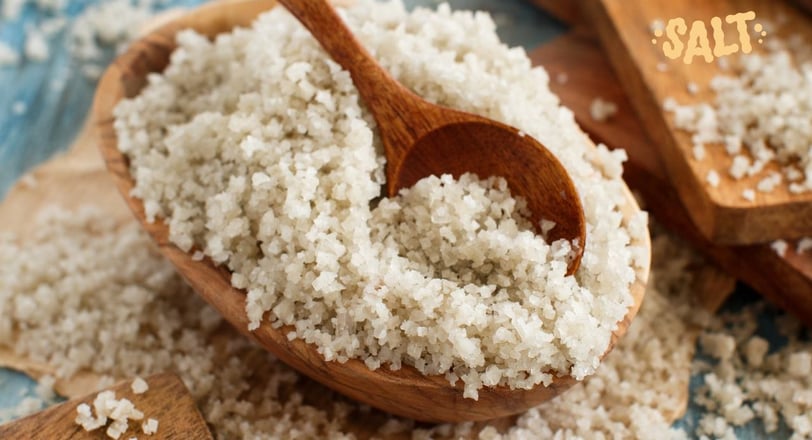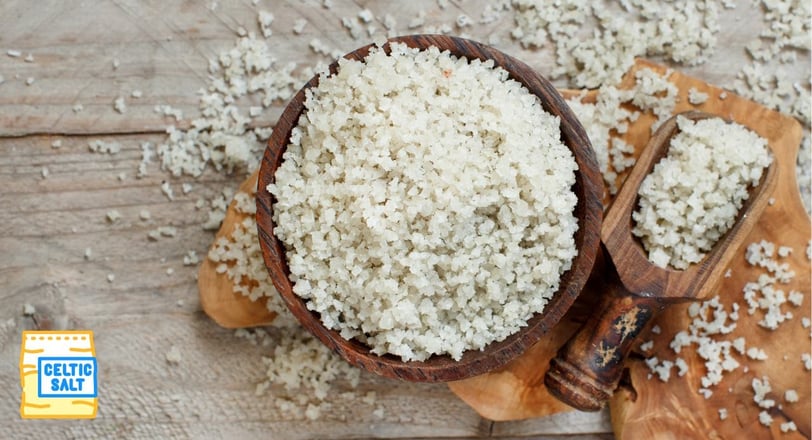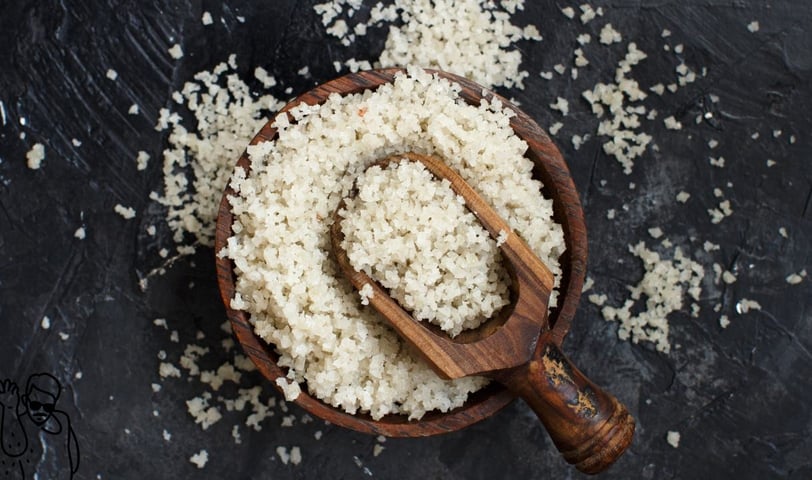Celtic Sea Salt
If you're curious about all the different types of salts available today, you've likely heard of Celtic salt. It's gaining popularity alongside more well-known salts like table salt, kosher salt, and Himalayan salt. But what exactly is Celtic salt, and should you be using it? Let’s break it down together.
What Is Celtic Salt?
Celtic salt, often called "sel gris" or "gray salt," is a type of sea salt known for its grayish hue. This color comes from the minerals it contains, like magnesium, calcium, potassium, zinc, and iron. Unlike the fine grains of table salt, Celtic salt has larger, coarser crystals. What’s interesting is that during its processing, not all the water evaporates, giving it a slightly damp texture.
Where Does Celtic Salt Come From?
Originally, Celtic salt was harvested from the Celtic Seas near northwestern France, but now it’s collected from various coastlines worldwide. It’s essentially the salt left behind after seawater evaporates, giving it its natural, mineral-rich quality.
Health Benefits of Celtic Sea Salt
Celtic salt is minimally processed, meaning it retains trace minerals that can be beneficial, like magnesium and potassium. Some health enthusiasts even suggest adding it to water for better hydration, although the science behind this claim isn’t conclusive. While these minerals are beneficial, you can typically get them from other sources like fruits and vegetables without increasing your sodium intake.
For people who sweat a lot or have electrolyte imbalances due to illness, Celtic salt might help restore some of those lost minerals, but it’s not a miracle cure. If you’re just looking to hydrate, drinking regular water is still your best bet.
How Is Celtic Salt Used?
Celtic salt can be used just like any other salt, but because of its coarse grains, it’s especially popular as a finishing salt for dishes. Keep in mind, it doesn’t dissolve as easily as finer salts like table salt, so if you're using it in cooking, a salt grinder can help. And since it lacks anti-caking agents, it may not mix as smoothly in recipes like regular salt does.
Some people believe swallowing a pinch of Celtic salt with water helps with hydration, but there are better ways to stay hydrated without consuming extra sodium.
Other Uses for Celtic Salt
Celtic salt isn’t just for eating! You can use it to:
Season your food for a more complex flavor.
Preserve foods like meats and vegetables.
Create a salt bath to help with relaxation and skin conditions like psoriasis.
Make a salt scrub by mixing it with natural oils to exfoliate your skin.
Celtic Salt Benefits
Some people believe that the higher levels of magnesium in Celtic sea salt help improve their hydration or to increase the other minerals. However, none of this has been proven.
There are some studies that show soaking in a sea salt bath may help ease some skin conditions, like psoriasis and dry skin.
Celtic Salt Side Effects
Like any other salt, consuming too much Celtic salt can lead to serious health issues such as high blood pressure, heart disease, or stroke. It’s always important to stick within the recommended daily limit for sodium intake.
Is Celtic salt good for you?
Celtic salt does have some minerals that regular table salt lacks, but it’s important to remember that too much salt, no matter the type, can lead to health problems like high blood pressure. The American Heart Association recommends limiting sodium intake to less than 2,300 milligrams per day, which is about 1 teaspoon. If you stick to this guideline, Celtic salt can be part of a healthy diet.


Other types of salt
Harvesters gather sea salt that is left behind when seawater evaporates.Other types of salt come from different sources and methods of production.
Common salt types include:
Table salt: Manufacturers mine table salt from salt deposits and process the product into fine crystals. Table salt is a combination of the minerals sodium and chloride. Manufacturers also typically add iodine, which helps prevent goiter.
Kosher salt: Manufacturers mine kosher salt from salt deposits. Kosher salt crystals are coarse and large. It does not contain additional iodine and undergoes less processing than table salt.
Pink Himalayan salt: Pink Himalayan salt is a coarse salt with large crystals. Harvesters gather it from a salt mine near the Himalayan Mountains in Pakistan. The salt contains sodium chloride and trace minerals and does not usually contain additional iodine.
Your Go-To Guide For:
Baking Soda VS Baking Powder: Uses, Substitutes, and Expert Cleaning Tips
For more articles, check out: KoolKitchen.pk
Celtic Salt vs Himalayan Salt
Both Celtic and Himalayan salts are sea salts, though Himalayan salt is mined from a salt mine in Pakistan. While they both contain trace minerals, Celtic salt is higher in calcium and magnesium, whereas Himalayan salt contains more potassium. However, the differences are so small that neither provides significant health advantages over the other.
In terms of sodium content, Celtic salt has around 500 milligrams in a quarter teaspoon, while Himalayan salt has slightly less at 420 milligrams. Interestingly, table salt, which is finer, packs 590 milligrams of sodium into the same measurement, making it the highest in sodium.
Is Celtic salt better than Himalayan salt?
There aren’t any studies that show that Celtic salt is better than Himalayan salt, but there are some small differences between the two. For example, Celtic salt has more calcium and magnesium. Himalayan salt, on the other hand, has the most potassium. That said, the amount is so small that there’s no difference in nutrition.


FAQs
Where Can I Buy Celtic Salt?
You can buy Celtic salt at many local grocery stores, especially in the specialty food sections, or at specialty food shops. It's also available online from various distributors. For convenience, you can buy Celtic salt on Amazon.
What is special about Celtic salt?
Celtic salt is harvested from coastal areas, making it a sea salt. What sets it apart is its trace minerals like magnesium, potassium, and calcium, which give it a grayish color. Most salts are just sodium, but Celtic salt has these additional elements, which some people believe give it a unique edge.
Which is better, Celtic or Himalayan salt?
Both Celtic and Himalayan salts are sea salts. There’s little difference between the two – not enough to make one better than the other.
Is Celtic salt the same as sea salt?
Celtic salt is also called Celtic sea salt because it is gathered from the seacoast.
What is the healthiest salt in the world?
There’s a lot of debate around whether sea salt is healthier than regular table salt. The truth is, there’s no solid evidence to prove one is better than the other for your health. However, one thing table salt has going for it is that it’s iodized, meaning iodine is added. Iodine is an essential nutrient that helps with thyroid function, so it’s important in your diet.
How can you take Celtic salt for high blood pressure?
If you’re dealing with high blood pressure, you’ll want to be cautious with any salt, including Celtic salt. High sodium intake is one of the main causes of high blood pressure, so using too much of any type of salt, even if it’s more “natural,” can still increase your risk.
What are the side effects of Celtic sea salt?
There are no specific Celtic salt side effects, but there can be side effects from consuming too much salt overall. Too much sodium increases your risk of high blood pressure, heart disease, and stroke.
Why Do People Put Celtic Salt Under Their Tongue?
You might have heard of people putting a pinch of Celtic salt under their tongue and then drinking water. Some believe this helps with hydration, but there’s not enough research to back up this practice. Drinking water alone is still the best way to stay hydrated.
How much Celtic salt should you consume daily?
The average adult should limit their sodium intake to around 2,300 milligrams per day, which is about a teaspoon of salt. A quarter teaspoon of Celtic salt contains about 500 milligrams of sodium, so if you’re using Celtic salt, a full teaspoon would almost hit that daily limit.
Why Is Celtic Sea Salt So Expensive?
Sea salts like Celtic salt tend to be more expensive than regular table salt because of how they’re harvested. The process of collecting sea salt from coastal areas is more labor-intensive, which drives up the price compared to the standard, mass-produced salts you find in most supermarkets.
Does Celtic Salt Help with Weight Loss?
While some people might claim that Celtic salt can help with weight loss, there’s no scientific evidence to support that idea. Salt, in general, isn’t going to be a magic solution for shedding pounds.




